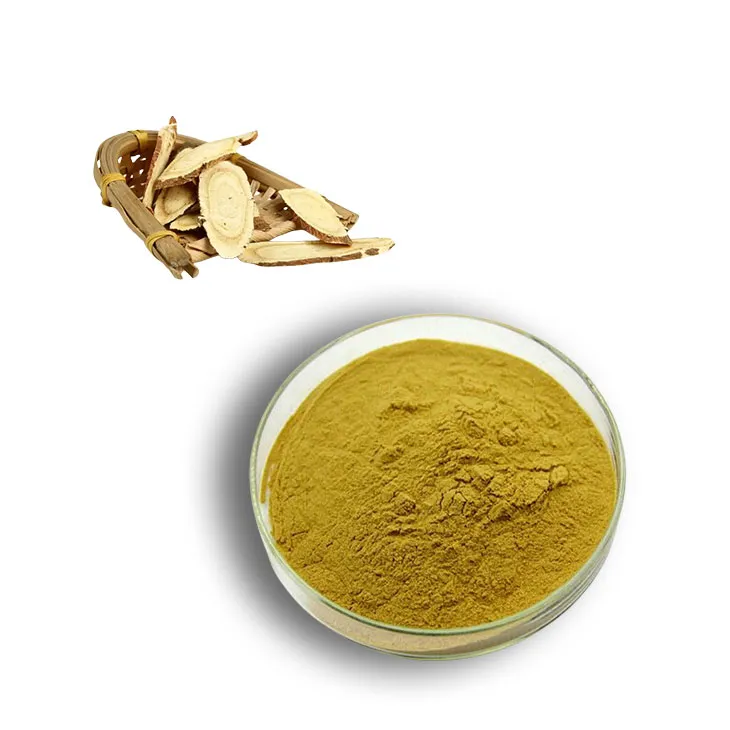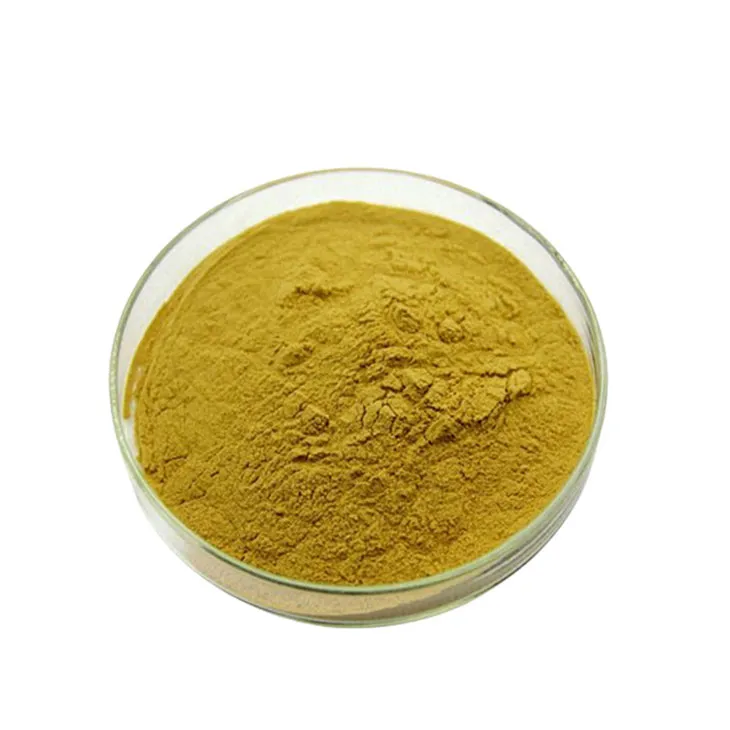- 0086-571-85302990
- sales@greenskybio.com
Licorice Root Extract Powder - Chinese Manufacturer, Supplier, Factory
2024-12-14

1. Introduction to Licorice Root Extract Powder
Licorice Root Extract Powder has been gaining increasing attention in the global market in recent years. Derived from the roots of the licorice plant (Glycyrrhiza), this extract powder is rich in various bioactive compounds. These compounds endow the powder with a wide range of properties, such as anti - inflammatory, antioxidant, and anti - microbial activities. In traditional Chinese medicine, licorice has been used for thousands of years for its medicinal properties. It is often used in combination with other herbs to enhance their effects or to reduce potential side effects.

2. China's Advantage in Licorice Root Extract Powder Production
2.1 Rich Herbal Medicine Tradition
China has a long - standing tradition in herbal medicine. This ancient knowledge forms a solid foundation for the production of licorice root extract powder. Chinese herbalists have accumulated extensive experience in understanding the properties of licorice roots over centuries. They know precisely when and how to harvest the roots to ensure the best quality. For example, the time of harvest can significantly affect the content of active ingredients in the roots. Chinese traditional knowledge helps manufacturers to select the most suitable raw materials for extraction.
2.2 In - depth Understanding of Licorice Roots
Chinese manufacturers possess a deep understanding of the properties of licorice roots. They are well - aware of the different chemical components present in the roots and their respective functions. Through continuous research and practice, they have mastered the techniques to extract and purify these components effectively. This enables them to produce licorice root extract powder with high purity and consistent quality. For instance, they know how to separate glycyrrhizin, one of the most important active ingredients in licorice, from other substances during the extraction process, ensuring a high - quality end product.

3. High - Quality Production by Chinese Manufacturers
3.1 Advanced Extraction Technologies
Chinese manufacturers utilize advanced extraction technologies to produce licorice root extract powder. They employ modern extraction methods such as solvent extraction, supercritical fluid extraction, and ultrasonic - assisted extraction. These techniques not only improve the extraction efficiency but also help to preserve the bioactivity of the active ingredients. For example, supercritical fluid extraction uses carbon dioxide under supercritical conditions to extract the desired compounds from licorice roots. This method is environmentally friendly and can produce a more pure extract compared to traditional extraction methods.
3.2 Stringent Quality Control
Quality control is of utmost importance in the production of licorice root extract powder. Chinese manufacturers adhere to strict quality control standards at every stage of production. They conduct thorough inspections of the raw materials to ensure their purity and quality. During the extraction and processing, they monitor key parameters such as temperature, pressure, and extraction time to ensure consistent product quality. After production, the finished product undergoes comprehensive quality testing, including assays for active ingredients, microbiological tests, and heavy metal detection. Only products that meet the highest quality standards are allowed to enter the market.

4. Service Excellence of Chinese Suppliers
4.1 Responsiveness to Customer Needs
Chinese suppliers are highly responsive to customer needs. Whether it is regarding product specifications, delivery time, or after - sales support, they strive to meet the requirements of their customers. If a customer has specific requirements for the product, such as a particular concentration of active ingredients or a specific packaging format, Chinese suppliers will do their best to customize the product accordingly. In terms of delivery time, they have efficient logistics systems in place to ensure timely delivery of the products. And for after - sales support, they are always ready to answer customers' questions and resolve any issues that may arise.
4.2 Product Customization
One of the key aspects of the service provided by Chinese suppliers is product customization. Given the diverse needs of customers from different industries and regions, Chinese suppliers are able to offer customized licorice root extract powder products. For example, in the food industry, customers may require a powder with a specific taste and functionality for use in food additives. Chinese suppliers can adjust the extraction process and formulation to meet these requirements. In the cosmetic industry, the powder may need to be formulated in a way that is suitable for skin application, and Chinese suppliers can also provide such customized products.

5. Research and Development Efforts by Chinese Factories
5.1 Exploring New Applications
Chinese factories invest significantly in research and development to explore new applications of licorice root extract powder. They collaborate with research institutions and universities to conduct in - depth studies on the properties of the extract powder. Through these efforts, they have discovered new potential applications in fields such as pharmaceuticals, nutraceuticals, and functional foods. For example, recent research has shown that licorice root extract powder may have potential in the treatment of certain chronic diseases, and Chinese factories are actively exploring ways to develop pharmaceutical products based on this finding.
5.2 Product Diversification
The research and development efforts also lead to product diversification. Chinese factories are able to produce different forms and grades of licorice root extract powder to meet the specific needs of various industries. They can produce fine - powder for use in high - end cosmetics, coarser powder for use in traditional herbal medicine preparations, and standardized extracts for use in the pharmaceutical industry. This diversification not only expands the market for licorice root extract powder but also enhances China's competitiveness in the global market.
6. Contribution to the Global Market
Chinese manufacturers, suppliers, and factories play a significant role in the global licorice root extract powder market. Their high - quality products, excellent service, and continuous innovation contribute to the growth and development of the market. By providing a reliable source of licorice root extract powder, they help meet the increasing demand from various industries around the world. Moreover, their research and development efforts drive the exploration of new applications and the expansion of the market. As a result, China has established itself as a major player in the global licorice root extract powder market, and is expected to continue to play an important role in the future.
FAQ:
What are the main advantages of glycyrrhiza root extract powder from Chinese manufacturers?
Chinese manufacturers have a long - standing tradition in herbal medicine. They deeply understand the properties of glycyrrhiza roots, which enables them to produce high - quality extract powder with unique characteristics. Also, Chinese suppliers are committed to providing excellent service in terms of product specifications, delivery time, and after - sales support.
How do Chinese factories ensure the quality of glycyrrhiza root extract powder?
Chinese factories draw on the long - standing knowledge of herbal medicine. They have in - depth research on glycyrrhiza roots. They use advanced production techniques and strict quality control systems during the production process to ensure the high quality of the extract powder.
What new applications has Chinese research and development explored for glycyrrhiza root extract powder?
Chinese factories invest in research and development. They have explored various new applications, which make the products more diverse and adaptable to different industries such as the pharmaceutical, food, and cosmetic industries. However, specific new applications may vary depending on different research results and market demands.
Are there any differences between glycyrrhiza root extract powder from Chinese manufacturers and those from other countries?
Yes, there are differences. Chinese manufacturers benefit from the traditional Chinese herbal medicine knowledge. This may lead to differences in the extraction methods, quality control, and product characteristics. Chinese products may have unique features due to the use of specific traditional techniques and understanding of the raw materials.
How can customers contact Chinese suppliers of glycyrrhiza root extract powder?
Customers can usually contact Chinese suppliers through various channels. They can search for suppliers on international business platforms, where suppliers often list their contact information. Also, they can participate in international trade fairs related to herbal products, where they can directly communicate with Chinese suppliers. Another way is to search for supplier information through industry - specific networks or associations.
Related literature
- The Properties and Applications of Glycyrrhiza Root Extract in Modern Medicine"
- "Glycyrrhiza Root Extract: Traditional Use and Modern Manufacturing in China"
- "Advances in the Research of Glycyrrhiza Root Extract Powder from Chinese Sources"
- ▶ Hesperidin
- ▶ citrus bioflavonoids
- ▶ plant extract
- ▶ lycopene
- ▶ Diosmin
- ▶ Grape seed extract
- ▶ Sea buckthorn Juice Powder
- ▶ Beetroot powder
- ▶ Hops Extract
- ▶ Artichoke Extract
- ▶ Reishi mushroom extract
- ▶ Astaxanthin
- ▶ Green Tea Extract
- ▶ Curcumin Extract
- ▶ Horse Chestnut Extract
- ▶ Other Problems
- ▶ Boswellia Serrata Extract
- ▶ Resveratrol Extract
- ▶ Marigold Extract
- ▶ Grape Leaf Extract
- ▶ blog3
- ▶ blog4
- ▶ blog5
-
Pure 85% Tomentil Extract.
2024-12-14
-
Marigold Extract
2024-12-14
-
Propolis Extract Powder
2024-12-14
-
Ivy Extract
2024-12-14
-
Alfalfa Meal
2024-12-14
-
Lemon Balm Extract
2024-12-14
-
Shikonin
2024-12-14
-
Soy Extract
2024-12-14
-
Echinacea Extract
2024-12-14
-
Saffron Extract Powder
2024-12-14
-
Europen Bilberry Extract
2024-12-14





















